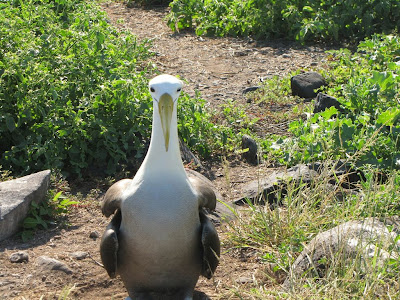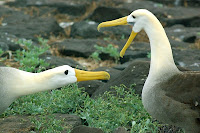
Here's one now - greeting us head on - completely unafraid - posing for the camera.
 |
| Mating Area |
Basic Facts
- The species of albatross that you will see is called the Waved Albatross.
- About the size of a large turkey, Waved Albatross are the largest birds in Galapagos, an archipelago literally teeming with bird life.
- Espanola is the only place in the world where Waved Albatross mate.
- Waved Albatross select a mate and the pair stays together for life
What Do Waved Albatross Look Like?
 |
| Close Up Posing for the Camera |
Adult albatross heads, necks and under wings are white or
yellowish. Their bodies are grayish,
brown and sienna colored. Their feet are
bluish and sort of long for their bodies.
Their bills are yellow. They get
the name Waved Albatross from the delicate wavelike pattern of their body
feathers.
Though aerodynamically perfect for gliding, Waved Albatross on
land are a bit funny looking and they can be a awkward when taking off and
landing. If land were not a necessity
for breeding, they would probably never touch down at all.
 |
| Cliff Side On Espanola Island |
Considering that they are based on a really rugged and
rocky terrain, it’s easy to understand why land is not their preferred habitat. Because their strength is in gliding and
finding food at sea, their wing span is very long, 7 feet in fact. While on
land, these birds have to find an area big enough to flap their wings on take
off and to stop without stumbling upon landing.
The way that they handle the take off is literally to jump off the
cliff. They take that initial leap of
faith, flap their wings, the current takes them and off they glide.
Now, the landing can be a little bit more treacherous
and I’ve seen many coming in for a landing full force, and stumbling on
touchdown. But, they don’t get
hurt.
 |
| Waved Albatross Landing |
 |
| Albatross in Flight |
Once in flight, Waved Albatross are perfect graceful gliders
and can go for long distances on the wind current. Catching the wind, they are truly
glorious to behold. They fly
by dynamically soaring on the wind currents. They can stay aloft for months at a time, diving down for food and landing only during breeding season. This raises a peripheral question. When and where
do these large birds sleep? No one really
knows. While some scientists believe that they take short naps when they land on
water as they feed, I personally subscribe to another scientific theory. Like dolphins, one of their brain hemispheres may sleep at a time, keeping them
conscious and on autopilot always. One thing is certain,
because most of the time they glide on wind currents, rather than flap their
wings, they really don’t use much energy to tire themselves out.
What Do Waved Albatross Eat?
The birds are pelagic, meaning that they are sea going. They get most of their nutrition from squid,
small fish and crustaceans that can be found on the ocean surface. They also are pirates. I’ve seen them many times stealing food that
other birds, especially the blue footed boobies, have caught. This behavior is called kleptoparasitism and
it’s not unusual in the bird kingdom.
It’s a way that different species have become co-dependent and have
learned to live harmoniously.
Fortunately, there’s plenty of food to go around.
The chicks eat from their mother’s and their father’s beaks,
the parent regurgitating its food and making it palatable for a young and
undeveloped tummy. In one feeding, a
chick can eat up to ½ gallon of oily fish.
Waved Albatross Mating Behavior
 |
| Getting to Know You |
The most exciting part of Waved Albatross behavior is
related to their mating patterns and how they raise their young chicks. Though most of the time they are flying,
gliding and eating, about 12,000 Waved Albatross pairs land each year on
Espanola to mate. Albatross live to be
about 50 years old and start mating behaviors at age 6. Thereafter, they keep that same mate for
their entire lives. They don’t spend the
interim time together, but somehow each spring the couples find one another
again. The males arrive first, patiently
waiting for their female counterparts to show up. We’re not sure how they know each other, but
just because they all look pretty much the same to us, doesn’t mean that they
don’t have some innate concepts of attraction that bind them together. Maybe they are looking for good providers, as
mutuality is an important part of their life together.
Interestingly, when a juvenile pair first meets, it’s not necessarily love at first sight. Mating usually does not occur even in the first year of their meeting. Their initial courtship is a drawn out ritual and might last two seasons before the pair actually mates.
 |
| Albatross Sky Pointing |
Here are some photos of their intricate mating dance:
When they do mate, Waved Albatross do so quite gently. A female lays only one egg, which is then tended to by both of the partners. The egg is laid in a depression in the hard volcanic earth. The partners will take turns sitting on and protecting the egg from their only predator, the Galapagos hawk and also keeping it warm. While one watches the egg, the other will go out to sea for as long as two weeks at a time to eat and glide. It takes more than two months for the egg to incubate.
 |
| Albatross Chick Photo Mark Putney Creative Commons |
It takes about 167 days before chicks can fly. Of course, they must shed the fluffy black
feathers and develop adult markings.
They must get strong, which they do by raising their bodies a little bit
more off the ground every day. Their wings have to develop so they exercise. They take some stumbling steps
around the boulders, learning about the terrain and how to use their spindly
legs. The first actual attempts at
flight will make you laugh. The little
babies are so awkward. Where do I put my
feet? What am I supposed to do with
these long wings? How do I avoid
stubbing my toe on a boulder? Am I going
to fall right off of that giant cliff?
Who knows what goes through those bird brains? What we do know is that after a few stumbling
efforts and falls, the six month old catches the wind and glides off as though
he’s been doing it all of his life. It
will be six years before he returns to his childhood home to start the cycle of
life over again.
There is some amazing video of albatross mating behavior and of
some amusing take offs and landings on YouTube. This one from Nature is a special favorite of
mine: http://www.youtube.com/watch?v=RBZkNwer7Co






No comments:
Post a Comment